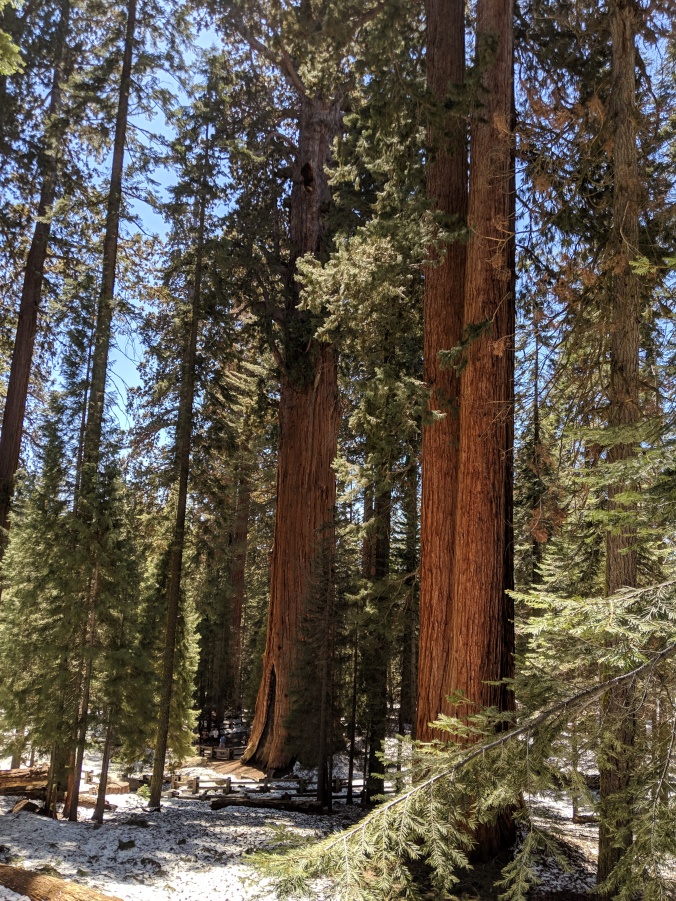April 23rd I headed down the road to explore Sequoia National Park, which is the sister park right next to Kings Canyon National Park. If there were no signs indicating landmarks you would not even know when you are entering and exiting each park, they are sometimes looked as if they are one park.
This view shows one of the world’s largest groves of trees. Redwood Mountain Grove covers 5 square miles of more than 2,100 giant Sequoias trees that are larger than 10 ft in diameter.
Also here is the largest area of wilderness in the lower 48 states covering the span of the Sierra Nevada Mountains that includes both the National Forest and National Parklands.
Further along the General’s Highway through Sequoia National Park, I came across Clover Creek Bridge and Creek which is about a mile from the Wuksachi Lodge turnoff. Clover Creek Bridge is one of two bridges that were constructed in 1930. It is a concrete bridge with a masonry facade, giving it the appearance of a stone bridge which gave it a rustic style appearance that fits in with the surrounding area. There was a small pullout where I was able to park my car and go have a closer look. With it being late April I enjoyed seeing the creek while it was gushing from new snowmelt.
My next stop was the General Sherman Tree Trail. I took this trail which is a mile round trip. At the time I was researching information I found that the shuttle bus does not go to the lower trailhead until summer and I did not know that I could have gotten a handicap pass to put in my car and park in the handicap area because of my bad knees. If I had done that it would have been a much shorter and easier walk…..But I was determined that I wanted to see the General Sherman Tree so I made the hike from the main upper trail that sits at 7000-foot elevation, it is a paved, steep grade path with a few steps and bench seating along the way. There was still snow around and plenty of melting snow runoff.
About 3/4 of the way down you will come to a viewpoint where you can view the General Sherman Tree from a distance. With it being so tall its hard to get a photo when you are closer to it, so you can get a good photo of the whole tree from this spot. There are also benches to sit on and an interpretive sign here that tells you about the General Sherman Tree.

When you finally make your way down to the General Sherman Tree there will be a lot of people lined up to take a photoshoot with the General. There is also a wooden fence around the perimeter of the tree to protect the shallow roots. As you continue walking there is a loop trail where you have the chance to see several other awesome trees, one being the massive fallen Sequoia that the trail goes through, two twin-trees, other Sequoias that have been burned or have interesting growths on them.
General Sherman Tree was named after Civil War General William Tecumseh Sherman…..this trees claim to fame as the biggest tree in the world comes from the volume of its trunk. Some trees are taller, but no other tree has more wood in its trunk. General Sherman stands 275 feet tall and is over 36 ft in diameter at the base. It is believed to be 2,200 years old and weighs about 1,385 tons. The Sherman tree top is dead, so it no longer gets taller, but its trunk keeps increasing. Each year the trunk grows wider, adding enough wood to equal another good-sized tree.
The next stop was the Giant Forest Museum, which to me was not really a museum. Here you are able to talk with rangers about the Sequoias and hiking in the area. It also has a small gift shop and the rest is a display that shares the story of the Giant Forest and Giant Sequoia Trees. The village market building which is listed on the National Register of Historic Places began renovations in 1999 and was converted to a museum and visitors center which was completed in the summer of 2001. The Sentinel which stands directly in front of the Giant Forest Museum is the 13th largest tree in Giant Forest, but the 21st largest in Sequoia National Park.
On the way back I stopped and took some pictures of the Marble Fork Kaweah River…..So pretty.
And finally here are just some other random nature pictures I saw on my drive




































































